 W
WThe Battle of Ad-Dawrah was a naval engagement fought on the night of 18 January and into 19 January in 1991 during the Gulf War. In the battle, Coalition forces captured an Iraqi offshore oil field forty miles from the Kuwaiti shore. The 29 POWs captured were the first POWs of the war. It was also the first surface engagement after the Coalition intervened in the war.
 W
WThe Allied invasion of Italy was the Allied amphibious landing on mainland Italy that took place on 3 September 1943 during the early stages of the Italian Campaign of World War II. The operation was undertaken by General Sir Harold Alexander's 15th Army Group and followed the successful invasion of Sicily. The main invasion force landed around Salerno on 9 September on the western coast in Operation Avalanche, while two supporting operations took place in Calabria and Taranto.
 W
WThe Battle of Anzio was a battle of the Italian Campaign of World War II that took place from January 22, 1944 to June 5, 1944. The operation was opposed by German forces in the area of Anzio and Nettuno. Nettuno was the German name for the Battle of Anzio.
 W
WThe Battle of Arawe was fought between Allied and Japanese forces during the New Britain Campaign of World War II. The battle formed part of the Allied Operation Cartwheel, and had the objective of serving as a diversion before a larger landing at Cape Gloucester in late December 1943. The Japanese military was expecting an Allied offensive in western New Britain, and was reinforcing the region at the time of the Allied landing in the Arawe area on 15 December 1943. The Allies secured Arawe after about a month of intermittent fighting with the outnumbered Japanese force.
 W
WThe Battle of Attu, which took place on 11–30 May 1943, was a battle fought between forces of the United States, aided by Canadian reconnaissance and fighter-bomber support, and Japan on Attu Island off the coast of the Territory of Alaska as part of the Aleutian Islands Campaign during the American Theater and the Pacific Theater.
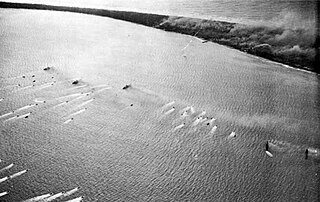 W
WThe Battle of Eniwetok was a battle of the Pacific campaign of World War II, fought between 17 February 1944 and 23 February 1944, on Enewetok Atoll in the Marshall Islands. The invasion of Eniwetok followed the American success in the Battle of Kwajalein to the southeast. Capture of Eniwetok would provide an airfield and harbor to support attacks on the Mariana Islands to the northwest. The operation was officially known as "Operation Catchpole", and was a three-phase operation involving the invasion of the three main islands in the Eniwetok Atoll.
 W
WThe Battle of Kwajalein was fought as part of the Pacific campaign of World War II. It took place from 31 January – 3 February 1944, on Kwajalein Atoll in the Marshall Islands. Employing the hard-learned lessons of the Battle of Tarawa, the United States launched a successful twin assault on the main islands of Kwajalein in the south and Roi-Namur in the north. The Japanese defenders put up stiff resistance, although outnumbered and under-prepared. The determined defense of Roi-Namur left only 51 survivors of an original garrison of 3,500.
 W
WThe Battle of the Barrier Forts was fought between American and Chinese forces in the Pearl River, Guangdong, China in November 1856 during the Second Opium War. The United States Navy launched an amphibious assault against a series of four forts known as the Barrier Forts near the city of Canton. It was considered an important battle by the British whose interest lay in capturing Canton.
 W
WOn 15 June 1944, United States Marine and Army forces landed on the southwest coast of the island of Saipan in the central Marianas chain. US forces declared Saipan secure on 9 July.
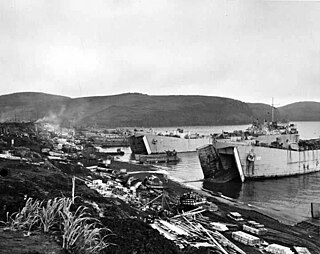 W
WOperation Cottage was a tactical maneuver which completed the Aleutian Islands campaign. On August 15, 1943, Allied military forces landed on Kiska Island, which had been occupied by Japanese forces since June 1942.
 W
WOperation Dragoon was the code name for the landing operation of the Allied invasion of Provence on 15 August 1944. The operation was initially planned to be executed in conjunction with Operation Overlord, the Allied landing in Normandy, but the lack of available resources led to a cancellation of the second landing. By July 1944 the landing was reconsidered, as the clogged-up ports in Normandy did not have the capacity to adequately supply the Allied forces. Concurrently, the French High Command pushed for a revival of the operation that would include large numbers of French troops. As a result, the operation was finally approved in July to be executed in August.
 W
WThe Second Battle of Fort Fisher was a successful assault by the Union Army, Navy and Marine Corps against Fort Fisher, south of Wilmington, North Carolina, near the end of the American Civil War in January 1865. Sometimes referred to as the "Gibraltar of the South" and the last major coastal stronghold of the Confederacy, Fort Fisher had tremendous strategic value during the war, providing a port for blockade runners supplying the Army of Northern Virginia.
 W
WThe Battle of Ganghwa was fought during the conflict between Joseon and the United States in 1871. In May, an expedition of five Asiatic Squadron warships set sail from Japan to Korea in order to establish trade relations, ensure the safety of shipwrecked sailors, and to find out what happened to the crew of the SS General Sherman. When American forces arrived in Korea, the originally peaceful mission turned into a battle when guns from a Korean fort suddenly opened fire on the Americans. The battle to capture Ganghwa Island's forts was the largest engagement of the conflict.
 W
WThe Guadalcanal campaign, also known as the Battle of Guadalcanal and codenamed Operation Watchtower by American forces, was a military campaign fought between 7 August 1942 and 9 February 1943 on and around the island of Guadalcanal in the Pacific theater of World War II. It was the first major land offensive by Allied forces against the Empire of Japan.
 W
WThe Second Battle of Guam was the American recapture of the Japanese-held island of Guam, a U.S. territory in the Mariana Islands captured by the Japanese from the U.S. in the 1941 First Battle of Guam during the Pacific campaign of World War II.
 W
WThe Battle of Hollandia was an engagement between Allies of World War II and Japanese forces during World War II. The majority of the Allied force was provided by the United States, with the bulk of two United States Army infantry divisions being committed on the ground. Air and naval support consisted largely of U.S. assets, although Australia also provided air support during preliminary operations and a naval bombardment force.
 W
WThe Battle of Inchon was an amphibious invasion and battle of the Korean War that resulted in a decisive victory and strategic reversal in favor of the United Nations Command (UN). The operation involved some 75,000 troops and 261 naval vessels, and led to the recapture of the South Korean capital of Seoul two weeks later. The code name for the operation was Operation Chromite.
 W
WThe Invasion of Lingayen Gulf, 6–9 January 1945, was an Allied amphibious operation in the Philippines during World War II. In the early morning of 6 January 1945, a large Allied force commanded by Admiral Jesse B. Oldendorf began approaching the shores of Lingayen. U.S. Navy and Royal Australian Navy warships began bombarding suspected Japanese positions along the coast of Lingayen from their position in Lingayen Gulf for three days. On 9 January, the U.S. 6th Army landed on a 20 mi (32 km) beachhead between the towns of Lingayen and San Fabian.
 W
WThe Battle of Iwo Jima was a major battle in which the United States Marine Corps and Navy landed on and eventually captured the island of Iwo Jima from the Imperial Japanese Army (IJA) during World War II. The American invasion, designated Operation Detachment, had the purpose of capturing the island with its two airfields: South Field and Central Field The strategic objectives were twofold: the first was to provide for B-29s unable to make it back to Tinian. The second was to provide air fields for shorter ranged fighters to be staged to extend fighter coverage to the bombers. The island could also serve as a staging point for attacks on Japanese main islands. The five-week battle saw some of the fiercest and bloodiest fighting of the Pacific War.
 W
WThe Landing at Aitape was a battle of the Western New Guinea campaign of World War II. American and Allied forces undertook an amphibious landing on 22 April 1944 at Aitape on northern coast of Papua New Guinea. The amphibious landing was undertaken simultaneously with the landings at Humboldt and Tanahmerah Bays to secure Hollandia to isolate the Japanese 18th Army at Wewak. Operations in the area to consolidate the landing continued until 4 May, although US and Japanese forces fought further actions in western New Guinea following a Japanese counter-offensive that lasted until early August 1944. Aitape was subsequently developed into an Allied base of operations and was used by Australian forces throughout late 1944 and into 1945 during the Aitape–Wewak campaign.
 W
WThe Landing at Amchitka was the amphibious landing operation and occupation of Amchitka island by American forces during the Aleutian Islands Campaign.
 W
WThe Landings at Cape Torokina, also known as Operation Cherryblossom, took place at the beginning of the Bougainville campaign in World War II. The amphibious landings were carried out by elements of the United States Marine Corps in November 1943 on Bougainville Island in the South Pacific, as part of Allied efforts to advance towards the main Japanese base around Rabaul under Operation Cartwheel. Coming in the wake of Allied successes at Guadalcanal and in the central Solomons, the landings were intended to secure a beachhead with the purpose of establishing several bases from which to project air and naval power closer towards Rabaul, in an effort to neutralize the large Japanese force that had been established there.
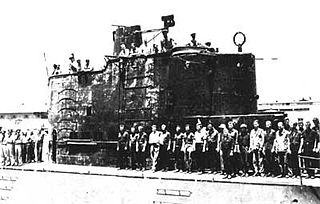 W
WThe Raid on Makin Island was an attack by the United States Marine Corps Raiders on Japanese military forces on Makin Island in the Pacific Ocean. The aim was to destroy Imperial Japanese installations, take prisoners, gain intelligence on the Gilbert Islands area, and divert Japanese attention and reinforcements from the Allied landings on Guadalcanal and Tulagi.
 W
WThe Battle of Makin was an engagement of the Pacific campaign of World War II, fought from 20 to 24 November 1943, on Makin Atoll in the Gilbert Islands.
 W
WThe Battle of Morotai, part of the Pacific War, began on 15 September 1944, and continued until the end of the war in August 1945. The fighting started when United States and Australian forces landed on the southwest corner of Morotai, a small island in the Netherlands East Indies (NEI), which the Allies needed as a base to support the liberation of the Philippines later that year. The invading forces greatly outnumbered the island's Japanese defenders and secured their objectives in two weeks. Japanese reinforcements landed on the island between September and November, but lacked the supplies needed to effectively attack the Allied defensive perimeter. Intermittent fighting continued until the end of the war, with the Japanese troops suffering heavy loss of life from disease and starvation.
 W
WThe Raid of Nassau was a naval operation and amphibious assault by Colonial forces against the British port of Nassau, Bahamas, during the American Revolutionary War. The battle is considered one of the first engagements of the newly established Continental Navy and the Continental Marines, the respective progenitors of the United States Navy and Marine Corps. The action was also the Marines' first amphibious landing. It is sometimes known as the "Battle of Nassau".
 W
WThe Normandy landings were the landing operations and associated airborne operations on Tuesday, 6 June 1944 of the Allied invasion of Normandy in Operation Overlord during World War II. Codenamed Operation Neptune and often referred to as D-Day, it was the largest seaborne invasion in history. The operation began the liberation of German-occupied France and laid the foundations of the Allied victory on the Western Front.
 W
WThe Battle of Okinawa , codenamed Operation Iceberg, was a major battle of the Pacific War fought on the island of Okinawa by United States Marine and Army forces against the Imperial Japanese Army. The initial invasion of Okinawa on April 1, 1945, was the largest amphibious assault in the Pacific Theater of World War II. The Kerama Islands surrounding Okinawa were preemtively captured on March 26th, (L-6) by the 77th Infantry Division. The 98-day battle lasted from March 26th until July 2nd, 1945. After a long campaign of island hopping, the Allies were planning to use Kadena Air Base on the large island of Okinawa as a base for Operation Downfall, the planned invasion of the Japanese home islands, 340 mi (550 km) away.
 W
WThe Battle of Puerto Plata Harbor took place in 1800 with France and Spain on one side, and the United States on the other, during the undeclared Quasi-War officially between the French First Republic and the United States.
 W
WThe Battle of Sansapor was an amphibious landing and subsequent operations around Sansapor, Dutch New Guinea on the Vogelkop Peninsula during World War II.
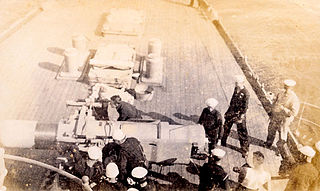 W
WThe Santo Domingo Affair, or the Santo Domingo Crisis, refers to an incident in 1904 involving the United States and Dominican militia forces in the Dominican Republic. After the death of a seaman from the USS Yankee on February 1, the U.S. military launched a punitive expedition which routed the Dominican forces.
 W
WThe Allied invasion of Sicily, codenamed Operation Husky, was a major campaign of World War II, in which the Allies took the island of Sicily from the Axis powers. It began with a large amphibious and airborne operation, followed by a six-week land campaign, and initiated the Italian Campaign.
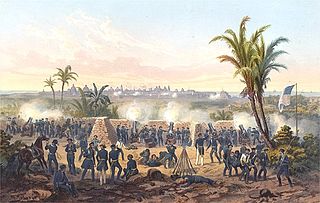 W
WThe Battle of Veracruz was a 20-day siege of the key Mexican beachhead seaport of Veracruz, during the Mexican–American War. Lasting from March 9–29, 1847, it began with the first large-scale amphibious assault conducted by United States military forces, and ended with the surrender and occupation of the city. U.S. forces then marched inland to Mexico City.
 W
WOperation Starlite was the first major offensive action conducted by a purely U.S. military unit during the Vietnam War from 18 to 24 August 1965. The operation was launched based on intelligence provided by Major general Nguyen Chanh Thi, the Army of the Republic of Vietnam (ARVN) I Corps commander. III Marine Amphibious Force commander Lieutenant General Lewis W. Walt devised a plan to launch a pre-emptive strike against the Viet Cong (VC) 1st Regiment to nullify their threat to the vital Chu Lai Air Base and Base Area and ensure its powerful communication tower remained intact.
 W
WThe Battle of Tarawa was a battle in the Pacific Theater of World War II that was fought on 20–23 November 1943. It took place at the Tarawa Atoll in the Gilbert Islands, and was part of Operation Galvanic, the U.S. invasion of the Gilberts. Nearly 6,400 Japanese, Koreans, and Americans died in the fighting, mostly on and around the small island of Betio, in the extreme southwest of Tarawa Atoll.
 W
WThe Battle of Tinian was a battle of the Pacific campaign of World War II, fought on the island of Tinian in the Mariana Islands from 24 July until 1 August 1944. The 8,000-man Japanese garrison was eliminated, and the island joined Saipan and Guam as a base for the Twentieth Air Force.
 W
WOperation Torch was an Allied invasion of French North Africa during the Second World War. The French colonies in the area were dominated by the French, formally aligned with Germany but of mixed loyalties. Reports indicated that they might support the Allies. American General Dwight D. Eisenhower, supreme commander of the Allied forces in the European Theater, planned a three-pronged attack on Casablanca (Western), Oran (Center) and Algiers (Eastern), then a rapid move on Tunis.
 W
WOperation United Shield was the codename of a military operation, conducted 9 January to 3 March 1995, bringing a conclusion to the United Nations Operation in Somalia II. Commanded by the United States, two ships of the Pakistan Navy, five ships of the Italian Navy and six ships of the United States Navy formed a Combined Task Force (CTF) ensuring the safe evacuation of all UN Peacekeeping Forces from Somalia.
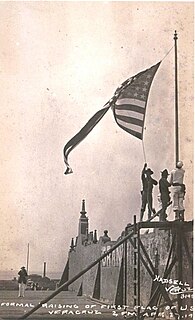 W
WThe United States occupation of Veracruz began with the Battle of Veracruz and lasted for seven months, as a response to the Tampico Affair of April 9, 1914. The incident came in the midst of poor diplomatic relations between Mexico and the United States, and was related to the ongoing Mexican Revolution.
 W
WThe Battle of Wakde (Operation Straight Line) was part of the New Guinea campaign of World War II. It was fought between the United States and Japan from 18 May 1944 to 21 May 1944 in Dutch New Guinea. The operation involved an assault on the Japanese-held Wakde island group by a reinforced US infantry battalion, which was transported from a beachhead the Allied troops had established around Arara, on the mainland, the previous day. Following the capture of the island, fighting on the mainland continued until September as Allied troops advanced west towards Sarmi. In the aftermath, the island's airbase was expanded and used to support operations around Biak and in the Marianas.